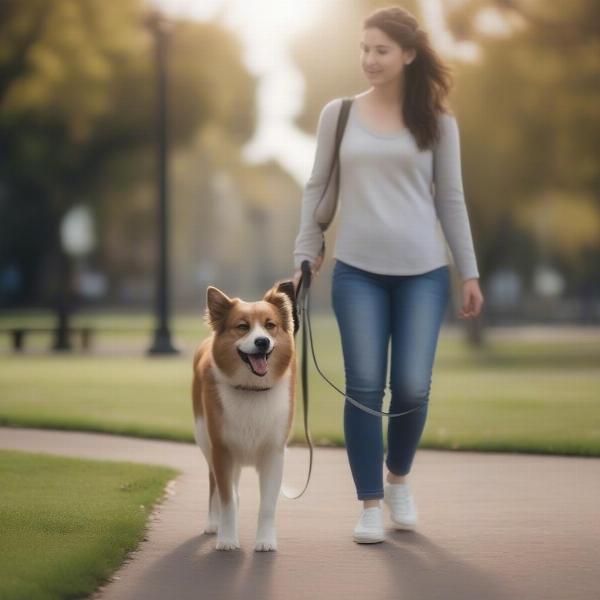Follow my lead dog training focuses on building a strong bond between you and your dog, creating a foundation of trust and understanding that makes learning enjoyable for both of you. This approach emphasizes clear communication, positive reinforcement, and consistency, leading to a well-behaved and happy companion. In this article, we’ll delve into the core principles of follow my lead training, explore its benefits, and provide practical tips to help you and your dog succeed.
Understanding “Follow My Lead”
Follow my lead isn’t just about your dog walking politely beside you; it’s about cultivating a shared focus and responsiveness. It signifies your dog’s willingness to pay attention to your cues and adjust their behavior accordingly. This attentive state sets the stage for learning various commands and behaviors. It helps your dog understand you are the leader, providing a sense of security and direction.
 Dog Following Owner's Lead
Dog Following Owner's Lead
Building a Strong Foundation: Key Elements of Follow My Lead Training
Successful follow my lead training hinges on several key elements:
- Positive Reinforcement: Reward desired behaviors with treats, praise, or a favorite toy. This motivates your dog and creates positive associations with following your lead.
- Consistency: Maintain clear and consistent cues. Use the same verbal commands and body language to avoid confusion.
- Patience: Training takes time and effort. Be patient with your dog and celebrate small victories along the way.
- Clear Communication: Use distinct verbal cues like “heel” or “with me” accompanied by clear body language, such as changing direction or pace.
Getting Started: Practical Steps for Follow My Lead Training
Start by teaching your dog to focus on you. Hold a treat near your face and lure them into a walking position beside you. As they walk with you, reward them with the treat and verbal praise like “good!” or “yes!”. Gradually increase the distance and duration of the walk, rewarding them for maintaining focus.
Addressing Common Challenges
- Pulling on the Leash: If your dog pulls, stop walking immediately. Once the leash is slack, continue walking. This teaches them that pulling results in a halt in progress. A dog support harness can also help.
- Distractions: Start training in a quiet environment with minimal distractions. Gradually introduce distractions as your dog progresses, rewarding them for maintaining focus amidst distractions.
- Lack of Motivation: Experiment with different rewards to find what motivates your dog the most. Some dogs respond best to treats, while others prefer toys or praise.
Beyond Basic “Follow My Lead”: Advanced Techniques
Once your dog masters the basics, you can introduce more advanced techniques like changing pace, making turns, and navigating obstacles. This will enhance your dog’s responsiveness and adaptability in various situations.
What are the Benefits of “Follow My Lead” Training?
- Enhanced Safety: A dog who follows your lead is less likely to run into traffic or encounter other dangers.
- Improved Socialization: Following your lead allows for controlled interactions with other dogs and people, fostering positive social skills.
- Stronger Bond: The shared focus and teamwork involved in “follow my lead” strengthens the bond between you and your dog.
- Reduced Stress: Clear communication and predictable responses reduce stress and anxiety for both you and your dog.
Conclusion
Follow my lead dog training is a powerful tool for building a strong and harmonious relationship with your dog. By focusing on positive reinforcement, consistency, and clear communication, you can teach your dog to follow your lead reliably and joyfully. This will not only improve your daily walks but also create a foundation of trust and understanding that extends to all aspects of your life together. Remember, patience and persistence are key to success in any training endeavor.
FAQ
- How long does it take to teach a dog to “follow my lead”? The time it takes varies depending on the dog’s age, breed, and previous training experience. It could take a few weeks or several months of consistent practice.
- What if my dog is very stubborn? Professional dog trainers can provide personalized guidance and address specific behavioral challenges. Don’t hesitate to seek their help.
- Can I use “follow my lead” training with a puppy? Yes, you can start introducing the concept of “follow my lead” as soon as your puppy is old enough to walk on a leash.
- Is “follow my lead” the same as heel? “Heel” is a specific command within “follow my lead.” “Follow my lead” encompasses a broader range of behaviors, including walking politely on a leash, paying attention to your cues, and adjusting their behavior accordingly.
- What kind of treats should I use for training? Use small, soft treats that your dog finds highly motivating. Dog food renal treats might be a good option for dogs with specific dietary needs. You can also try small pieces of cooked chicken, cheese, or hot dogs.
- How do I handle distractions during training? Start in a quiet area and gradually introduce distractions as your dog progresses. Reward them for maintaining focus despite the distractions.
- What if my dog starts pulling again after initial success? Regression is normal. Reinforce the training by going back to basics and rewarding desired behaviors consistently.
You Might Also Be Interested In:
About ILM Dog:
ILM Dog is your trusted international resource for expert dog care advice. We offer comprehensive guidance on dog breeds, health, training, nutrition, grooming, and much more. Whether you’re a new dog owner or a seasoned pro, our goal is to empower you with the knowledge and resources you need to provide the best possible care for your canine companion. For personalized advice or further inquiries, please contact us at [email protected] or +44 20-3965-8624. Visit us at ILM Dog today.